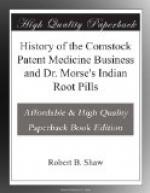To continue the business, a new partnership, also under the name of Comstock & Brother, comprising George Wells Comstock, William Henry Comstock, and Baldwin L. Judson, was formed on October 1, 1853. Judson was the husband of Eliza, a sister of Lucius and his brothers. George contributed one half of the capital of the new firm and the other two, one quarter each; however, exclusive possession of all trademarks, recipes, and rights to the medicines was reserved to George. It is not clear precisely when Judson entered the drug business or first became associated with the Comstocks; there is some evidence that he had previously been in business for himself, as several remedies were registered by him prior to this time. Judson’s Chemical Extract was registered with the Smithsonian by the Comstock firm in 1851, but Dr. Larzetti’s Juno Cordial or Procreative Elixir had previously been entered by Judson & Co. in 1844. A variant of the Juno Cordial label also mentions Levi Judson (a father?) as Dr. Larzetti’s only agent in America.
Besides the “new” remedies, the Comstock firm—both Comstock firms—was also selling all of the “old” patent medicines, most of them of British origin. These included such items as Godfrey’s Cordial, Bateman’s Pectoral Drops, Turlington’s Balsam of Life, British Oil, and others. The only strictly American product that could claim a venerability somewhat approaching these was Samuel Lee’s Bilious Pills, patented on April 30, 1796.
Most of the more recent remedies probably had been originated by local doctors or druggists, either upon experimentation or following old folk remedies, and after enjoying some apparent success were adopted by drug manufacturers. With rare exceptions, however, the names of the discoverers never seem to have made their way into medical history.
[Illustration: FIGURE 3.—Original wrapper for Judson’s Chemical Extract of Cherry and Lungwort, printed about 1855.]
Entrance of Dr. Morse’s Indian Root Pills
During the summer of 1855 the Comstock firm, now located at 50 Leonard Street, was approached by one Andrew J. White, who represented himself as the sole proprietor of Dr. Morse’s Indian Root Pills and who had previously manufactured them in his own business, conducted under the name of A.B. Moore, at 225 Main Street, in Buffalo. Actually, White’s main connection with this business had been as a clerk, and he had been taken in as a partner only recently. Nevertheless, the Comstocks accepted his claims—carelessly, one must believe—and on August 10, 1855, signed a contract with White for the manufacture and distribution of these pills.
The originator of these pills was Andrew B. Moore. This is clear from several legal documents, including an injunction proceeding in behalf of White and Moore in 1859, which reads in part as follows:




